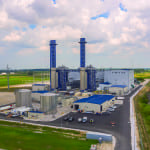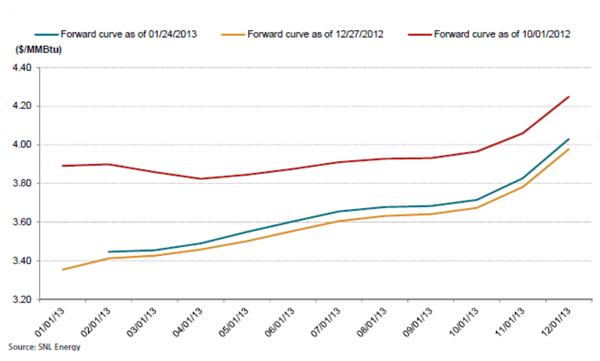Natural gas-fired generation enjoyed a competitive advantage through this past winter and spring as historically low prices for the commodity combined with mild weather and relatively light demand to turn the dispatch stack on its head and favor gas over coal. That advantage is narrowing as summer demand approaches. A senior market analyst with Bentek Energy expects coal-fired generation to be advantaged at least until the fall shoulder season.
“The power market is the arena for gas and coal to duke it out this summer,” said Tony Sweet, who focuses on demand-side fundamentals for the Colorado-based analytics firm. He said current market dynamics are largely untested ground and feature unusually low natural gas prices and historically high gas storage inventories and coal stockpiles.
The Energy Information Administration (EIA) said in its most recent Short-Term Energy Outlook (STEO) that gas burn for electric power generation is expected to peak in the third quarter at 31.2 billion cubic feet a day (Bcf/d). That compares with 27.7 Bcf/d during the third quarter of 2011.
Beginning last fall and continuing through much of early 2012, natural gas held a clear advantage. At one point in May, natural gas demand for power generation was as much as 7 Bcf/d higher than during the same period in 2011—around 26 Bcf/d. Demand was strongest among power generators in the Northeast and Southeast, where gas-fired generation displaced coal-fired resources, including coal sourced from Wyoming’s Powder River Basin.
Natural gas spot prices averaged $1.95/MMBtu at the Henry Hub in April 2012, the EIA said. That was down $0.23 per MMBtu from the March 2012 average and the lowest average monthly price at the benchmark pricing node since March 1999. The EIA said in its May STEO that it expects the Henry Hub natural gas price will average $2.45/MMBtu in 2012, a downward revision from its April estimate.
Reports of gas production reductions helped spur a natural gas price rally, which resulted in prices rising some 40% from 10-year lows of around $2.20/MMcf. Natural gas demand for power remained strong, but its year-over-year growth shrank early this month to around 1 Bcf/d compared with June 2011.
“During the spring, gas didn’t achieve the full potential of coal-to-gas switching,” Sweet said. Some generators were forced to burn coal to maintain reliability and reduce stockpiles. Others faced take-or-pay penalties that obliged them to make room for new deliveries. In some cases, Sweet said, power generators had to find alternative locations to stockpile coal, increasing handling costs and indirectly benefiting gas by boosting the total cost of coal-fired generation.
Another market dynamic has been historically high gas storage inventories and coal stockpiles. The five-year average amount of gas in storage as of June 1 is 2.19 trillion cubic feet (Tcf), according to the EIA. Gas in storage as of June 1, 2011 was 2.16 Tcf, and rose to almost 2.88 Tcf as of June 1, 2012, a difference of more than 700 Bcf. The storage overhang, along with forecasts for normal summer weather, helped push down the price of natural gas for July delivery from $2.80/MMcf at the end of May to around $2.27/MMcf as of June 7. That was more than $2.57 lower than a year ago.
Coal stockpiles are at historic highs, too, around 205 million short tons. The previous record stockpile was 203 million short tons in 2009. That oversupply is putting pressure on producers to cut coal production and also is suppressing prices.
The situation may be tough for gas and coal producers, but it creates a golden moment for power generators who are able to take advantage of this coal vs. gas pricing dynamic. Generators that ran peaker plants as baseload units during the winter and spring may be reluctant to do so this summer, due to reliability concerns during peak demand season. In Texas in particular, all available generating resources are expected to be called on for reliability.
Sweet said natural gas prices are unlikely to rally unless lackluster residential and commercial demand increases this coming winter, significant production reductions occur, or new power generation demand occurs. As a result, he said he expects electric power generators to continue experiencing competitive coal and natural gas prices at least until this fall.
—David Wagman is POWER’s executive editor. A version of this story first appeared in POWERnews.









